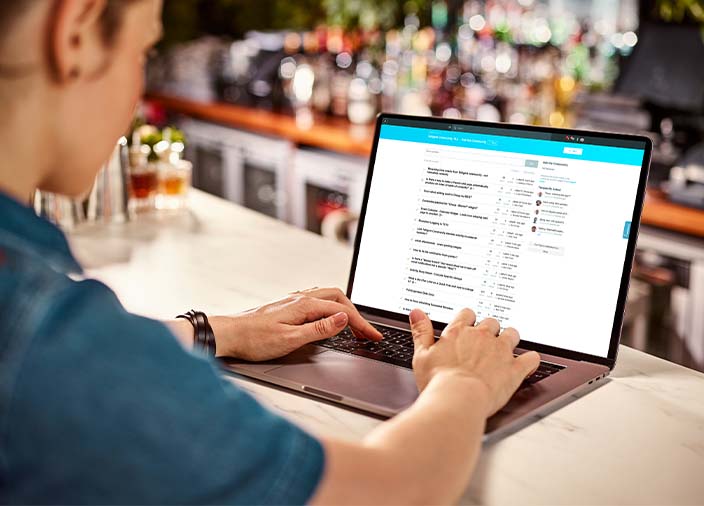
The Bartender’s Guide To Conflict Management
Discover how to resolve conflict within your team and with customers to improve your bar's operations.
Estimated reading time: 9 minutes
Closing down conflict
Conflict is sometimes unavoidable within a bar environment. The stress, pressure, and often fast-paced nature of the work can all have an impact. As a bar manager or team leader, it's your responsibility to help resolve conflict. Discover how to recognise, prevent, and address conflict to increase your team's collaboration and foster a good relationship with your customers.
Managing conflict in a team

Managing conflict in a team
A team that works together thrives together. Disagreements are inevitable, but managing conflicts effectively can help to maintain a positive work culture. By learning conflict management skills, you can improve your team's cohesiveness and create a harmonious environment where everyone pulls in the same direction and delivers exceptional customer service.
The main sources of conflict

The main sources of conflict
A key component of managing conflict is to be aware of common sources so you can easily spot the signs as they arise and be prepared to minimise their impact. These include:
Communication Breakdown - Communication is key within a bar team. Conflict can occur if staff can't easily share instructions or updates or if a team member doesn't follow them. Plus, team members can become frustrated if communication is entirely one-way.
Conflicting Priorities - Not everyone in a team will be as passionate about their work as others, while some may favour a different style of service than the rest of their team. A clash in ideas and priorities can be a hotbed of conflict. The best way to solve it is to have everyone know what to expect and what the standards are.
Stressful Work Conditions - Stress is a major trigger for conflict, and a busy bar can be stressful. So, a manager needs to try to find ways to reduce this.
Steps for preventing conflict

Steps for preventing conflict
As well as being prepared to address issues, it is even better to be able to prevent them from happening by following these steps.
Open Communication - Encourage clear and open communication within your team - bars work better when the team is in constant dialogue. Ask your team to send clear instructions to all staff members – keeping everyone aligned and reducing potential conflict opportunities. Create space for all staff to voice ideas and suggestions.
Set Clear Expectations - When everyone knows the expected standards it minimises conflict opportunities, even if staff have different priorities.
Defined roles and responsibilities - Your staff members can get easily frustrated when they don't understand each other's roles. Likewise, staff can feel under-appreciated if they feel their efforts aren't recognised. Avoid this by making roles and responsibilities during service clear.
Ongoing training - It's good for bar managers to provide continued training on key topics that could cause conflicts, like diversity and unconscious bias.
How to manage conflict

How to manage conflict
Conflict can still break out even with preventative measures in place. If it does, bar managers or team leaders must act quickly. It can be uncomfortable trying to address conflict, but doing so is for the betterment of your entire bar team. The two key things you need to do to address conflict are:
Actively listen and understand the complaint: Always listen to the views of all parties involved in a conflict. Do it somewhere private where everyone feels comfortable being honest. Give everyone equal time to express their thoughts and concerns while being impartial as you listen. You're not here to pick sides. Instead, you need to find solutions.
Provide guidance and collaborate to find an approach that addresses the issues: Once you've allowed everyone to express their opinion, find common ground and a shared goal for everyone to work towards. Provide guidance for everyone to achieve that goal and set in place timings to check that progress was being made.
Managing conflict with customers

Managing conflict with customers
Sometimes, conflict can come from an outside source, usually with a customer complaint. Every bar team member needs to learn how to handle customer complaints, as they can be intimidating for the inexperienced. The best way to deal with customer complaints is to treat them as a learning experience. Actively engage and listen to the complaint to see what went wrong and what your team can do to avoid it happening again.
Dealing with in-person customer complaints

Dealing with in-person customer complaints
When things go wrong, and a customer complains about the service or a staff member, follow these steps to de-escalate the situation and find a solution.
Apologise - Be sincere and sympathetic. Being on their side will build a connection and show that you want to help them.
Listen - Take in their complaint to fully understand the situation. Don't interrupt, and try not to solve the issue too quickly, as it looks like you're trying to brush them off and gives the impression that they're an inconvenience.
Ask Questions - Asking questions shows you're engaged with the issue and want to know more. It helps you better understand the problem.
Take Action - Own the problem and act immediately to rectify the situation. Give a clear indication of how you will resolve the issue. Even if the solution isn't obvious, you can let them know you’ll come back to them with a solution.
Thank Them - A complaining customer often feels awkward about bringing an issue to your attention. Show that you're appreciative and that their feedback will help the venue by thanking them.
Tackling online customer complaints

Tackling online customer complaints
Customers often find it easier to leave reviews and complaints online because they want to avoid confrontation. Complaints online can be damaging for a bar, as these are public and may prevent potential customers from visiting. This is why you need to handle online complaints properly. Follow these Do's and Don'ts to handle online complaints perfectly:
Do: Read the comment thoroughly. Try to understand the problem and what is upsetting the customer.
Do: Take the conversation offline. Write an apologetic response on the forum and then message privately to find a resolution with the customer.
Do: Post your response publicly. Show online customers that you care and want to resolve the issue.
Do: Encourage a return visit. Get the customer back to show what you've changed to improve their experience. Offer a complimentary drink or voucher.
Don't: Leave it too late to respond. Customers don't like to feel ignored. Make sure to check your reviews regularly and be prompt with your responses.
Don't: Take it personally. A bad review isn't an attack. Be curious to learn more and how to fix the problem.
Don't: Promise to fix something you can't. Be realistic about what you can do to solve a complaint.
Key Takeaways
Many things can cause conflict in a team, such as stressful environments, poor communication, and a lack of understanding of each other's roles.
Preventing conflict is better than fixing it. Set clear expectations and roles.
When resolving conflict, listen to all sides and work to create a common goal.
Conflict with customers can be challenging to deal with. Always be apologetic with complaints and try to find a solution.
Online complaints are common. Always respond to show you care and try to find a solution.
Sign up for free and become a member of Diageo Bar Academy today to unlock the latest industry news, trends, and tips to keep your bar knowledge up to speed!
Related content

Treating Guests to a Great Experience
When guests visit your venue, they want to have a great time. Read on to learn how you can deliver great experiences to guests in your bar.
Bar Management
Take your bartending skills to the next level with valuable insights, tools, techniques and online courses to enhance your bar career.
Customer Complaints and Service Recovery
Handling complaints effectively can make or break a business. Learn how to handle them effectively to turn the guest experience around.
Effective Team Mentoring and Coaching
Discover the difference mentoring and coaching can make to your staff's confidence, teamwork and capability to deliver success.
How to Retain a Dream Bar Team
Reducing staff turnover is key for hospitality businesses. Improving staff retention will reduce your recruitment costs and increase return on investment in training, while a happier team will deliver more for your guests and your business.
